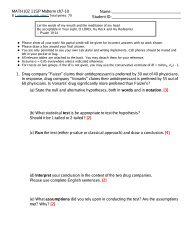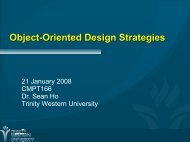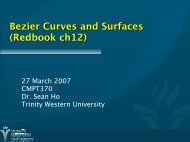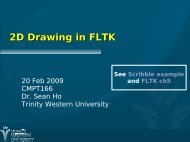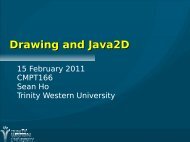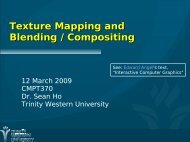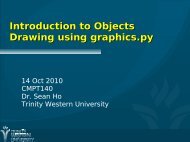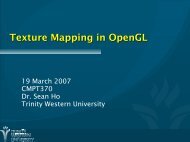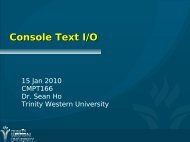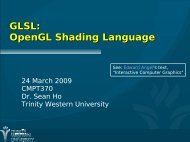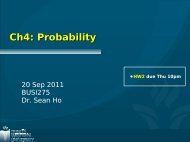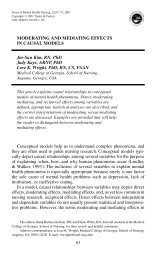One-way ANOVA and Follow-up Analysis
One-way ANOVA and Follow-up Analysis
One-way ANOVA and Follow-up Analysis
You also want an ePaper? Increase the reach of your titles
YUMPU automatically turns print PDFs into web optimized ePapers that Google loves.
<strong>ANOVA</strong> concepts How much of variability in purchase amount isdue to country of origin?● SS tot= SS Country+ SS residual● SS Countryis “between-gro<strong>up</strong>” variation (SSB)● SS residualis “within-gro<strong>up</strong>” variation (SSW) Do the gro<strong>up</strong> meansdiffer significantly?● F-test, p-value Fraction of variabilityexplained by country?Sale ($)y CAy USy Oty● η 2 (equiv. to R 2 )CanUSOtherCtryBUSI275: <strong>One</strong>-<strong>way</strong> <strong>ANOVA</strong> 8 Nov 20115
<strong>ANOVA</strong> table Model: Y = (offset due to gro<strong>up</strong>) + (residual ε)- Gro<strong>up</strong> (Between) Residual (Within)SSkSSB = ∑i=1n i ( ̄y i − ̄y) 2kSSW = ∑i=1n∑i y ij− y i 2j=1df k – 1 n – kMS = SS/df MSB = SSB / (k – 1) MSW = SSW / (n – k) Test statistic is F = MSB / MSW● Model vs. residual (as in regression!)● Use FDIST() with two dfs to get p-valueBUSI275: <strong>One</strong>-<strong>way</strong> <strong>ANOVA</strong> 8 Nov 20116
<strong>Follow</strong>-<strong>up</strong> analysis <strong>ANOVA</strong>'s global F test is an omnibus test:● Just says there is a difference somewhere● Doesn't tell us which gro<strong>up</strong>s differ! There may be sets of gro<strong>up</strong>s thatdon't differ significantly from each other <strong>Follow</strong>-<strong>up</strong> analysis tries to find these● Post-hoc: try all pairs of gro<strong>up</strong>s The multiple comparisons problem:“shotgun” approach leads toinflated Type I error● Planned contrasts: if theory guides us to trycertain comparisons of gro<strong>up</strong>sBUSI275: <strong>One</strong>-<strong>way</strong> <strong>ANOVA</strong> 8 Nov 20118
Post-hoc: Tukey-Kramer Considers all possible pairings of gro<strong>up</strong>s● (Can vs. US), (Can vs. Other), (US vs. Other)● In general, k*(k-1) pairings! From table in Appendix J, find critical value for q● Test statistic for studentized range (like F)● Use α (.05 or .01) <strong>and</strong> both dfs to look <strong>up</strong> For each pairing (gro<strong>up</strong> i vs. gro<strong>up</strong> j):● Find st<strong>and</strong>ard error:SE =√ MSW2 ( 1 n i+ 1 n j)● Compare difference of means: |x i– x j|against critical range: (q)*(SE)● If larger, then these gro<strong>up</strong>s differ significantlyBUSI275: <strong>One</strong>-<strong>way</strong> <strong>ANOVA</strong> 8 Nov 20119
Tukey-Kramer: Delivery.xls Which manufacturers differ significantly? Appendix J (p.867): α=0.05 (95% conf)● df = (2, 9) ⇒ q = 3.20 Calculate SE for each pairing31 2 Calculate critical rangefor each pair: q*SE Compare againstmean differences:q 3.20Pair: 1 vs 2 1 vs 3 2 vs 3SE 0.303 0.279 0.317Crit Range: 1.024 0.940 1.071Mean diff: 0.633 1.175 1.808Result FALSE TRUE TRUE Conclusion: manufacturer 3 is the odd one out,with significantly higher operating costsBUSI275: <strong>One</strong>-<strong>way</strong> <strong>ANOVA</strong> 8 Nov 2011 10
<strong>ANOVA</strong> <strong>and</strong> regression With only 1 dichotomous IV:● <strong>ANOVA</strong> = t-test = regressionSale ($)y CAy US● Code the IV as 0/1CanUS Intercept b 0= mean of gro<strong>up</strong> 0 (y 0) Slope b 1= difference of means● Effect size η 2 = R 2 If the IV has multiple levels, use dummy coding:● Choose a reference level● Make k-1 dummy variables, foreach of the other levels:each coded 0/1● Use multiple regressionCty US OtCa 0 0US 1 0Ot 0 1BUSI275: <strong>One</strong>-<strong>way</strong> <strong>ANOVA</strong> 8 Nov 2011 11
TODO HW7 (ch10,14): due tonight Projects:● Acquire data if you haven't already If waiting for REB: try making <strong>up</strong> toy dataso you can get started on analysis● Background research for likely predictors ofyour outcome variable● Read <strong>up</strong> on your chosen method of analysis(regression, time-series, logistic, etc.)BUSI275: <strong>One</strong>-<strong>way</strong> <strong>ANOVA</strong> 8 Nov 2011 12



